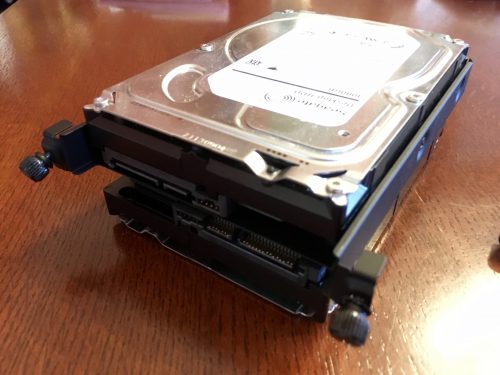Have you ever wondered if mounting a hard disk drive on its side or even upside-down affects its lifespan or reliability? According to every drive manufacturer, it’s perfectly acceptable to mount a hard disk drive in any orientation as long as it’s not tilted and has sufficient cooling. File this under “now you know”…

My new server case, the NZXT H440, has five drive sleds with mounting holes for one drive on top and another on the bottom. Although this makes power and data cable routing a little more interesting, it’s perfectly fine to mount drives like this. Especially with the H440, since there are three very large fans blowing air across them at all times!
Just to make sure, here’s what each drive manufacturer says on the subject of drive mounting:1
- Seagate: “All Seagate and Maxtor-brand hard drives can be fitted sideways or upside down. As long as they are not moved during use and get enough cooling, it is irrelevant in which direction they are mounted.”
- Western Digital: “The drive can be mounted sideways, on end, or even upside down as long as the mounting screws are used properly.”
- HGST: “Hitachi Deskstar drive can be mounted with any side or end vertical or horizontal. Do not mount the drive in a tilted position.”
So it’s perfectly fine to mount a hard disk drive upside down, vertical, or on either end as long as it’s secure from vibration and shock, not tilted at an angle, and gets enough cooling. This is no surprise since every vendor sells external USB drives with vertical or end-on mounting.2
Here’s my entire FreeNAS series so far:
Cannot find an actual quote, but HGST expert said that tilted position restricted only because it’s difficult to test all possible angles.
I would say keep well away from Seagate rotating drives, just lately I seem to be having loads of their drives failing. I do IT Support and it’s only conjecture but I think they are cutting corners to try and keep the price lower than SSDs. As the SSDs are getting closer to HDD prices they have gone too far and drive failures appear to be on the rise.
I really don’t think it matters what angle you put drives, if they work fine upside down I can’t see how any orientation matters?
I’d always been told to mount them with the circuit board facing down, so that if any metal debris were to fall, it wont land on the PCB and short something out.
here’s my question..i believe I’ve read and or been told that sure, you can mount in any orientation but that it is bad for the drive to change orientation at some point during the life of the drive. Is this true?
My question is pretty simple: can I store multiple external drives together, one on top of another?
I believe that mounting the hard drive horizontally with platter above the read-head-arms may produce a longer lifespan for the drive. When a drive is mountedhorizontally and the drive is powered off, or just starting up, Its possible for the read/write head to touch the platter. Less so if the drive is mounted with printed circuit board on top (esthetically, upside down).
The drive heads read from both sides from the platter, so head-wise it symmetric.
“…any orientation as long as it’s not tilted…” That seems like a contradiction.
Henry Ford, 1909: “A customer can have a car painted any color he wants as long as it’s black.”
thanks for clearing out my worries.
i installed my 3.5inch hdd into the optical bay. i put polyethylene foam under it i form of two thick strips, in order to get some airflow and BOT to block the breather hole..
i used zipties and its so damn silent . even More silent than the stupid hdd sleds on this dell inspiron 660 tower. the drive is an hdd enterprise hdd back frim 2008 or something, and i bought it used in 2020.. its pretty old and it works fine…. the vibration in the main hdd bay was SO high, that whenever i closed to sidepanel, the drive would get pending sectors like CRAZY. and the whole case would vibrator more than the “adult toys”.
but now, its sooo silent. im a sucker for HDD clicking sounds . that sound got so damn lower than i miss it now used to be, when the drive was in the stupid drive bay, the case would amplify the vibration and noise of the drive. but now i have to get ky ear soooo close to it.. i hate wd drives cuz of that drive… ill get seagate… frim 2013 or something.. .cux that’s what i can afford… thanks for reading my adventure